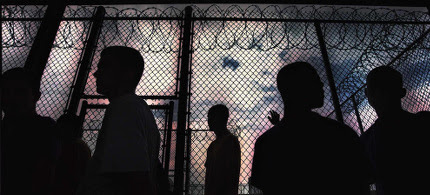
Prisoners inside prison yard. (photo: AP)
By John Kiriakou, Reader Supported News
The country’s two largest private prison corporations, GEO Group and Corrections Corporation of America (CCA) released their annual financial reports last week, showing that they each made thousands of dollars in profits per prisoner incarcerated. GEO made a profit of $2,135 per prisoner, while CCA squeezed out $3,356. This is most certainly not cause for celebration.
Indeed, every American should be appalled that there are companies that profit on human misery and that can guarantee a profit only by denying human beings basic medical care and necessities. Moreover, the national conversation should not be one of how to incarcerate more and more people for less and less money, but how to rehabilitate them at a cost far less than incarceration.
The research and policy organization In the Public Interest estimates that the cost of rehabilitation is not only significantly lower than the cost of incarceration, ($35,350 per prisoner in the federal system) it is, in many cases, even lower than the per-person profits of the private prison companies. For example, the annual cost per prisoner of community-based services for arrested teenagers is only $1,000; resources and support for released prisoners re-entering society is $1,200; math, reading, and writing classes in prison are $1,600; vocational training in prison is $2,000; and substance abuse counseling for released prisoners is $2,700. Even residential drug treatment as an alternative to prison is $17,000 per person, less than half the cost of incarceration.
But remember, the goals of GEO and CCA are not to rehabilitate anyone. Those companies only make money if there are more prisoners, if they serve longer sentences, if they reoffend after release, or if the companies can keep costs so low by reducing money spent on food or medical care that they can then pass the savings and profits on to the stockholders.
With that in mind, what are conditions like inside America’s private prisons? I served 23 months in federal prison. Conditions were poor, with food and medical care at the bottom of the barrel. I saw three inmates die because they did not receive adequate medical care. But the federal system is supposed to be the best prison system in the country. I heard fellow prisoners talk about having been in private prisons during the transportation process to federal prison. They told stories about 200 prisoners with access only to one toilet, with a broken seat, no less. They talked about 150 prisoners with access to one television, with fistfights breaking out every hour on the hour over what show to watch.
Toilet seats and televisions are not the main problems in America’s private prisons. A 2013 lawsuit by the American Civil Liberties Union against the privately-owned East Mississippi Correctional Facility called it “an extremely dangerous facility operating in a perpetual state of crisis, where prisoners live in barbaric and horrific conditions and their basic human rights are violated daily.”
That was only the beginning. The lawsuit detailed “a litany of horrors,” including “rampant rapes; placing prisoners in solitary confinement for weeks, months, or even years at a time, where the only way to get a guard’s attention in an emergency is to set a fire; rat infestations so bad that vermin crawl over prisoners.… The untreated mentally ill throw feces, scream, start fires, electrocute themselves, and self-mutilate.” The ACLU accused prison officials of “denying or delaying treatment for infections or even cancer.” Malnourishment, chronic hunger, stabbings, beatings, and the rape of juveniles housed with adults also were common.
This situation is not unique to East Mississippi. A 2011 ACLU study found that common occurrences in private prisons across the country included “horrifying cases of abuse, including juveniles’ cells smelling of urine and feces, insect infestations, racial segregation, punishment for speaking Spanish, and refusal of medical health treatment.” This isn’t “rehabilitation.” It isn’t even prison. It’s hell.
President Obama has spoken recently of the need for rehabilitation, coupled with incarceration. Rehabilitation is the only way to reduce recidivism. That’s a proven fact. But as long as the justice system farms prisoners out to for-profit prisons, where they are abused and denied their basic human rights and medical care, we are no better than countries with the world’s worst prison systems. There is only one solution. We must close for-profit prisons and swear by a policy to never treat human beings in such a way again. President Obama has the authority to do that singlehandedly. Whether he has the guts to remains to be seen.














